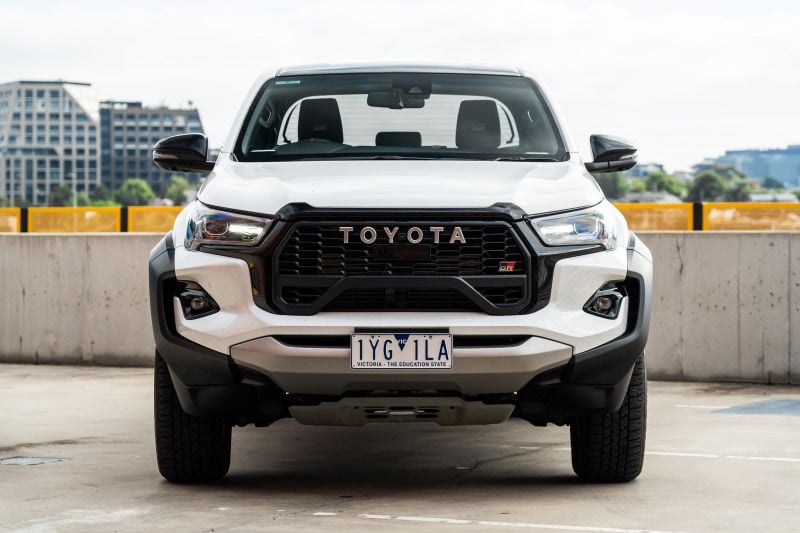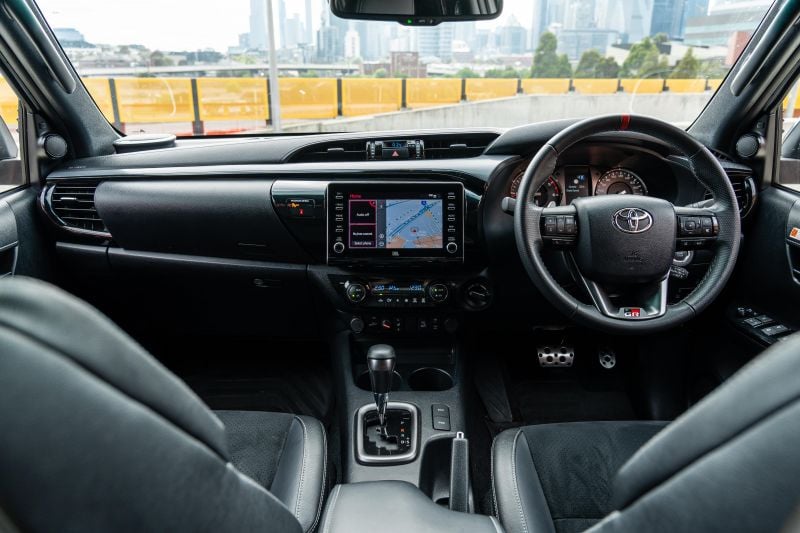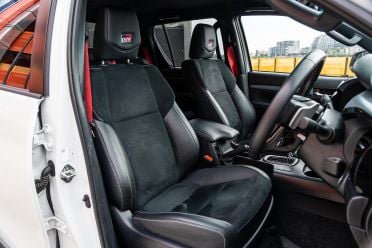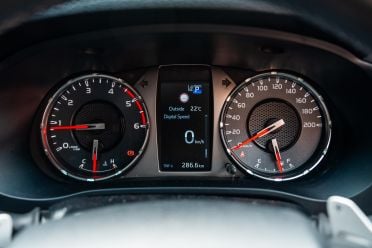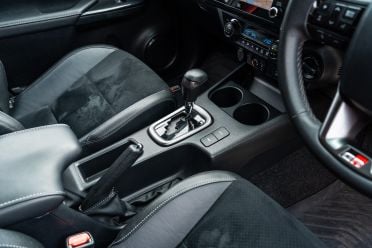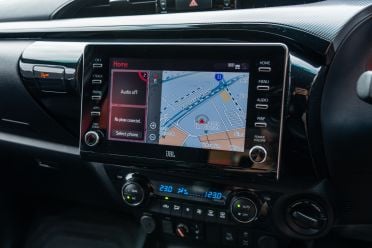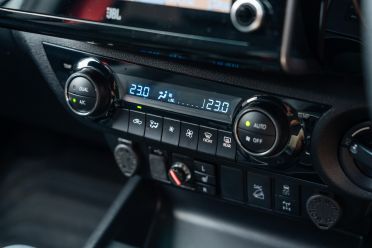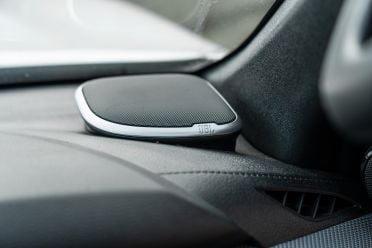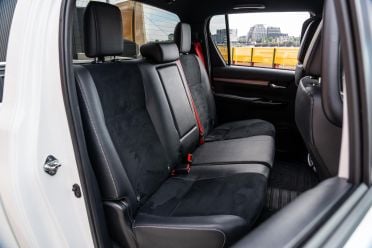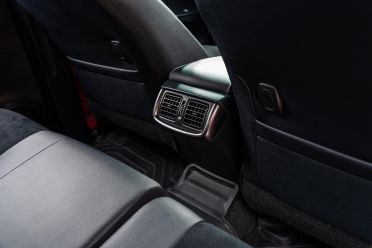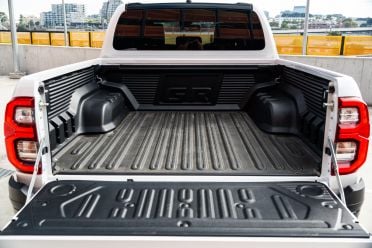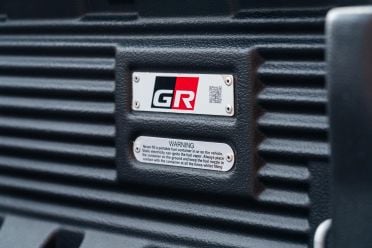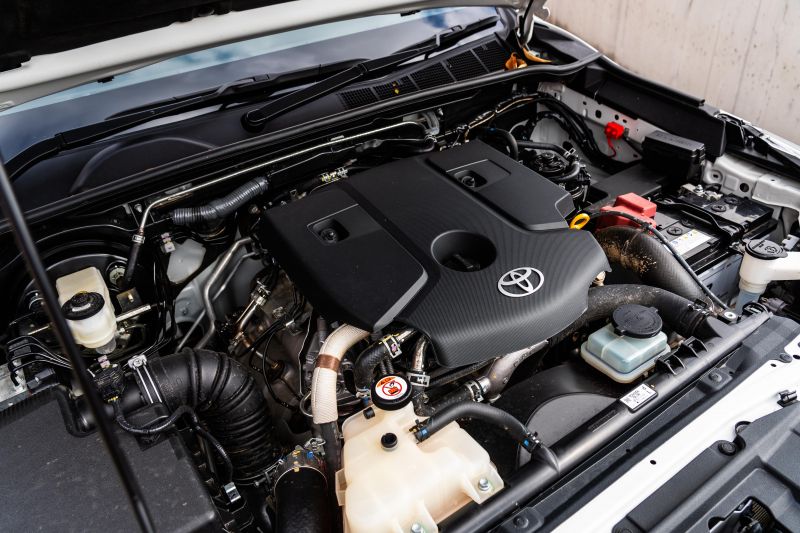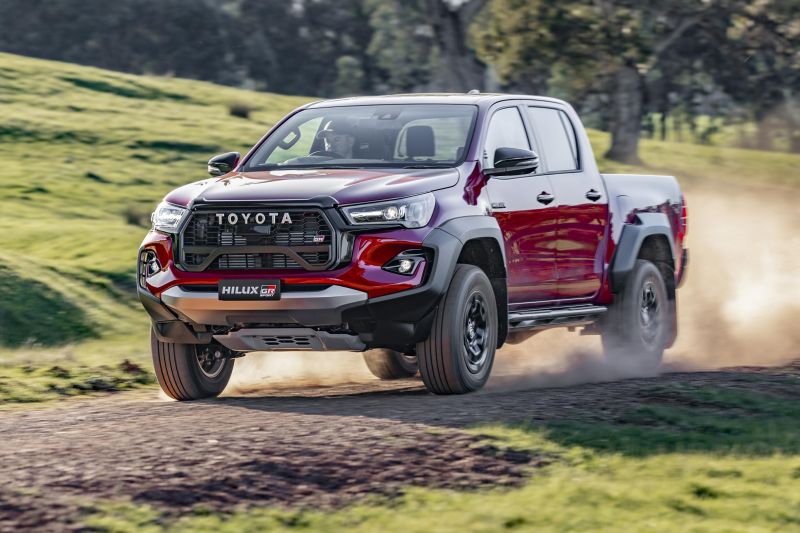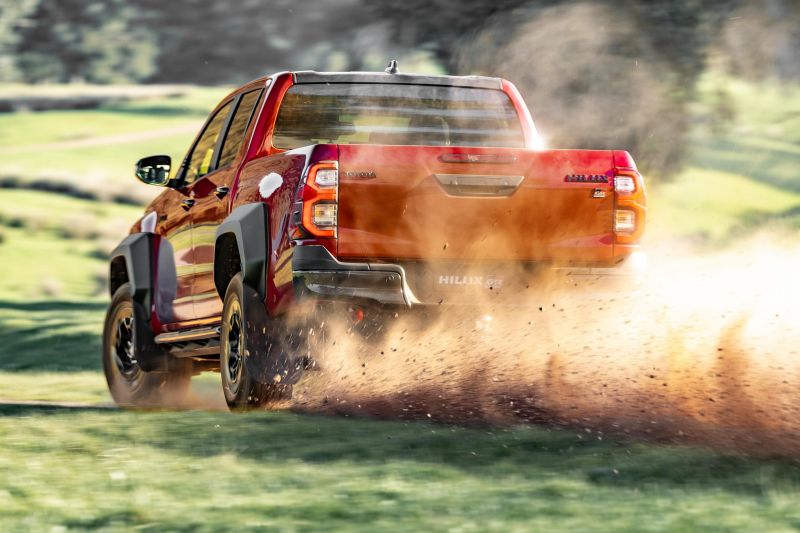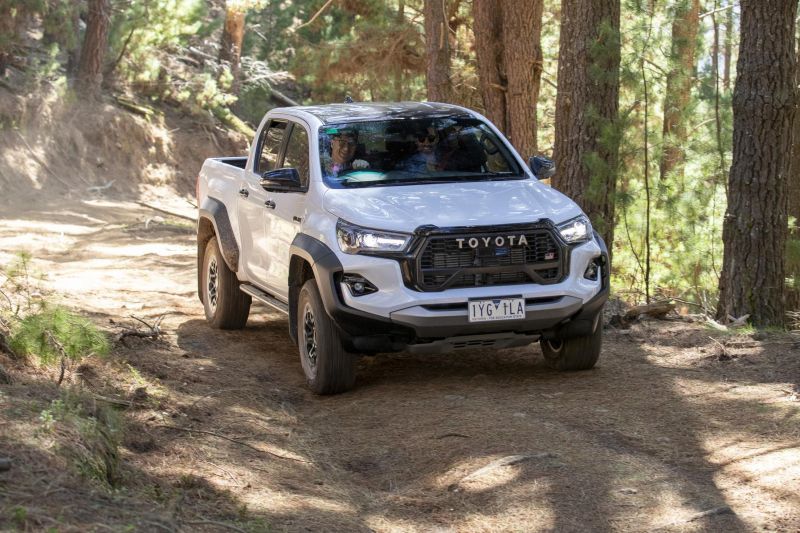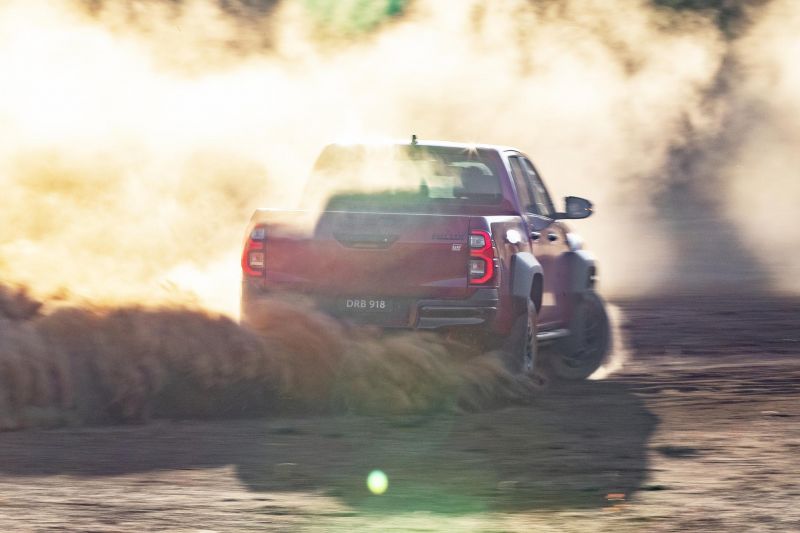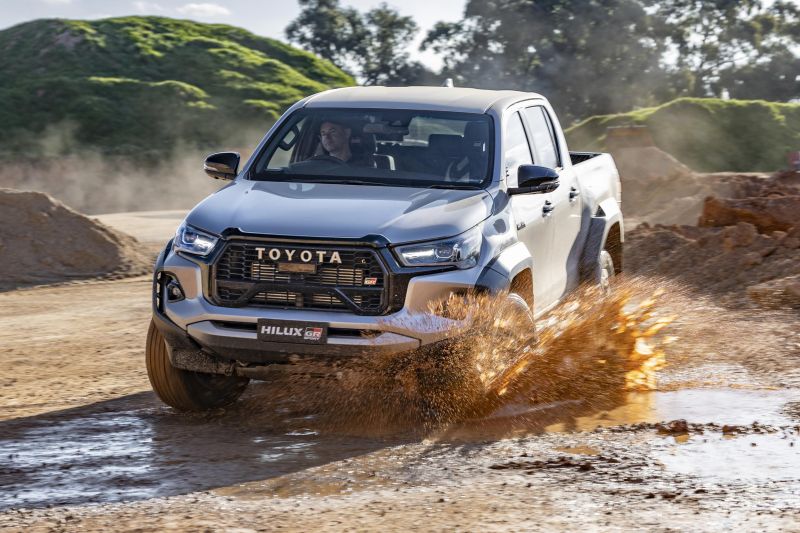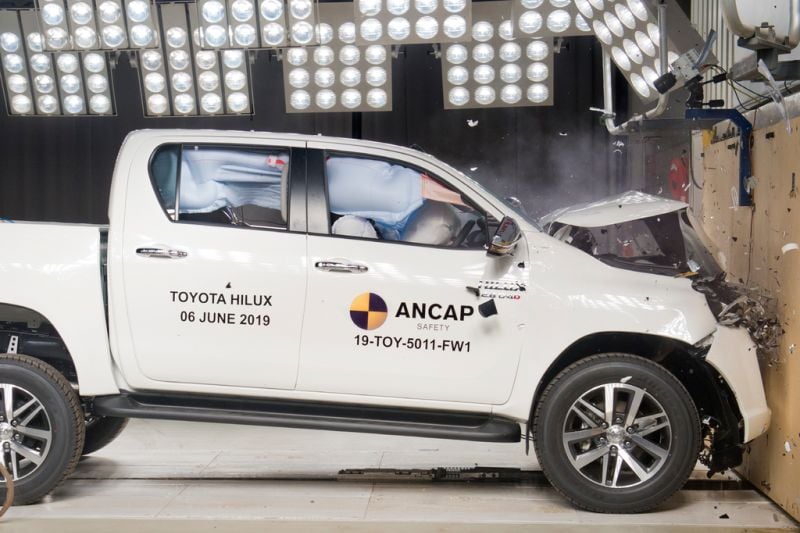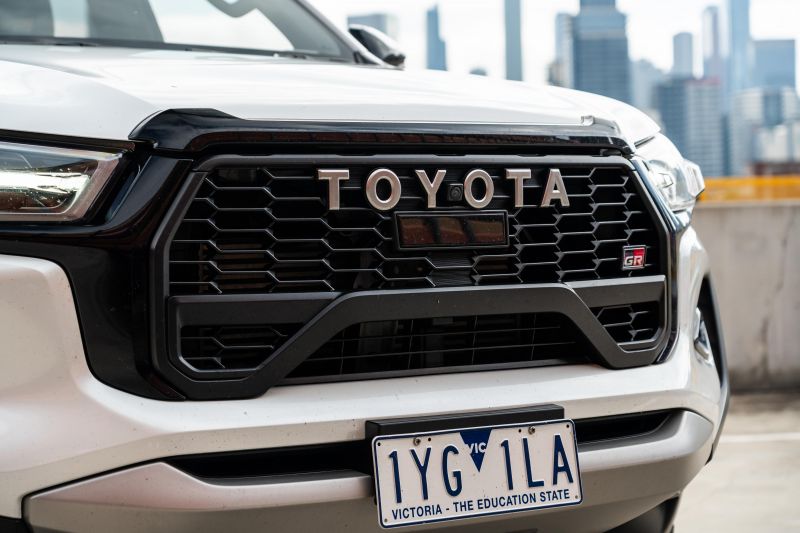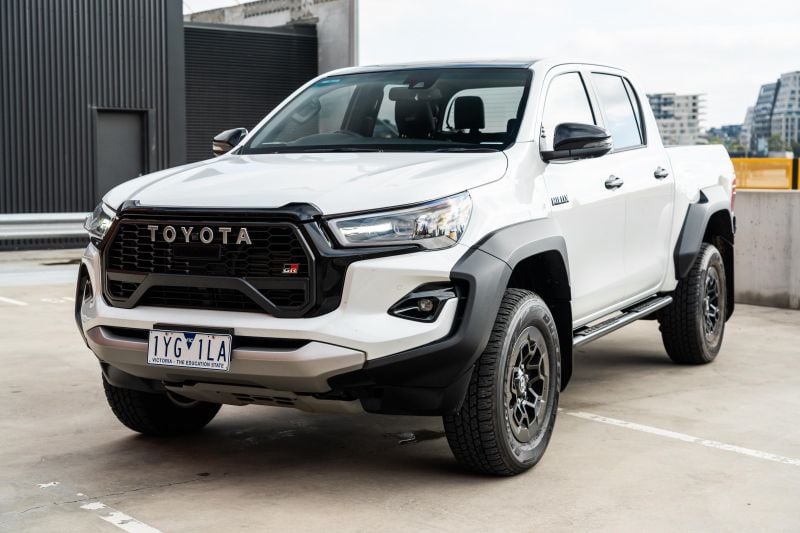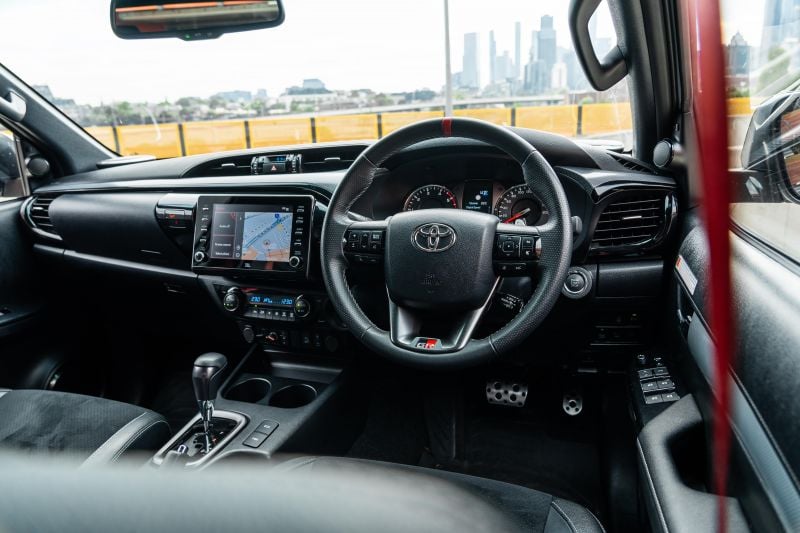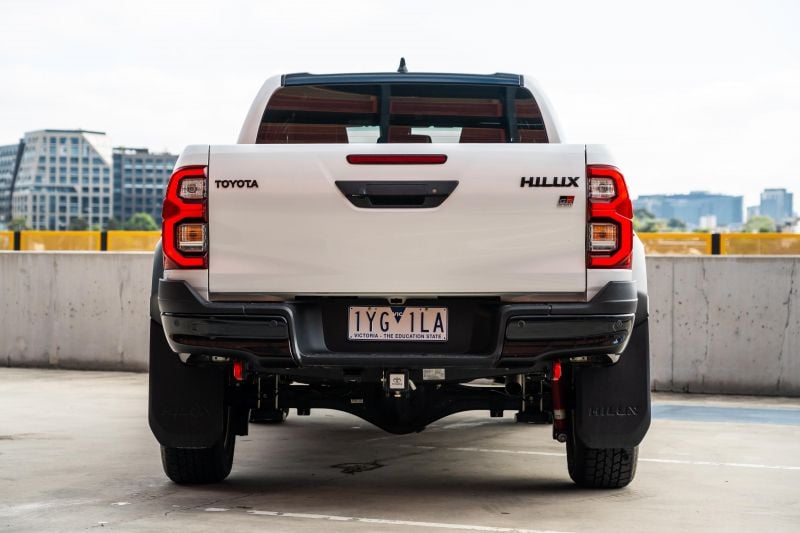The Toyota HiLux is a vehicle that doesn’t need an introduction.
This Thai-built ute was Australia’s top-selling vehicle bar none for seven consecutive years, but for the last two years it has been pipped at the post by the locally developed but also Thai-made Ford Ranger.
The current-generation HiLux dates back to 2015, though it has received a few minor updates over the years. Its IMV ladder-frame platform dates back all the way to 2004, however.
One of the most interesting additions to the current HiLux range in recent years was the flagship GR Sport, which was first introduced in 2023.
Developed by Toyota Australia designers and engineers, this new range-topping ute was inspired by the Japanese carmaker’s Dakar Rally-winning HiLux race truck, but stops short of being a fully fledged HiLux GR model to compete directly with the Ranger Raptor.
WATCH: Paul’s video review of the 2024 Toyota HiLux GR Sport
Highlighting the upgrades over regular HiLux 4×4 dual-cab variants is extra power and torque from the venerable 2.8-litre four-cylinder turbo-diesel, a tweaked transmission to handle the extra oomph, a unique suspension setup, and unique GR Sport exterior and interior design cues.
It’s been a few years since this top-shelf HiLux ute has been on sale now, and besides some very minor spec changes, it has stayed the same during that time.
Is this still the best version of the current HiLux range? Read along to find out.
How does the Toyota HiLux compare?
View a detailed breakdown of the Toyota HiLux against similarly sized vehicles.

Toyota
HiLux
How much does the Toyota HiLux cost?
The HiLux GR Sport remains the flagship trim level of the popular ute range, but despite its higher outputs it misses out on the 48V mild-hybrid V-Active Technology introduced in other HiLux variants last year, including the cheaper Rogue.
HiLux 4×4 dual-cab pickup pricing:
| Model | Price before on-road costs |
|---|---|
| 2025 Toyota HiLux Workmate 2.4TD 6MT | $48,420 |
| 2025 Toyota HiLux Workmate 2.4TD 6AT | $50,420 |
| 2025 Toyota HiLux SR 2.8TD 6MT | $52,640 |
| 2025 Toyota HiLux SR 2.8TD 6AT | $55,190 |
| 2025 Toyota HiLux SR 2.8TD 6AT with V-Active | $56,210 |
| 2025 Toyota HiLux SR5 2.8TD 6MT | $60,670 |
| 2025 Toyota HiLux SR5 2.8TD 6AT with V-Active | $63,260 |
| 2025 Toyota HiLux Rogue 2.8TD 6AT with V-Active | $71,530 |
| 2025 Toyota HiLux GR Sport 2.8TD 6AT | $74,310 |
If you want to see how the Toyota HiLux lines up against the competition, check out our comparison tool
What is the Toyota HiLux like on the inside?
The HiLux GR Sport looks properly tough. Design is subjective, but it’s arguably the best the current-generation HiLux – or for that matter any HiLux – has ever looked on the outside, and that’s thanks to Toyota’s Australian design team.
The theme continues inside. Like many utes, it’s a fair hike into the cabin, though thankfully there are chunky grab handles on the A-pillar and rock sliders on the side of the ute to make hopping in a touch more graceful.
Once you’re in, you sit up high and have a commanding view of the road ahead. It rides 15mm higher than other core HiLux 4×4 dual-cab variants due to suspension upgrade and this is noticeable from the seat of the pants.
As standard there are special-looking, heavily bolstered sport bucket seats upholstered in black leather and suede. There’s even a GR insignia on the head restraint and red seat belts, both of which are fancy touches – especially in a ute.
Both the front seats are comfortable and offer enough support, plus the driver’s seat has eight ways of electric adjustment, including thigh support. This is great for those with longer legs, like myself.
A strange omission is there’s no lumbar adjustment. Though this was largely a non-issue, my back did start to ache during longer drives on bumpier roads.
The front seats offer heating as standard, though this wasn’t much use in the scorching Melbourne heat. And the button placement for it looks a lot like an afterthought because it just fills in a blank button on the centre console stack.
Ahead of the driver is a typical HiLux steering wheel, but its leather wrapping makes it look and feel a touch more special. There’s a 12 o’clock marker at the top of the wheel, adding to the sporty theme this ute exudes.
All the buttons on the steering wheel are logically placed, though interacting with them isn’t the most rewarding as they feel a bit squidgy and doughy.
Unlike other HiLux variants, the GR Sport picks up paddle shifters behind the steering wheel, which can be handy if you want to take direct control over the transmission in scenarios like towing.
Like every HiLux variant, the instrument cluster setup is basic and easy to understand, though it’s dated compared to its rivals. There are two physical dials for the revs and speed, and a 4.2-inch digital information display between them.
With the latter, you know you’re driving the HiLux GR Sport because there’s a GR logo that flashes up on startup.
On the screen there are a few informative pages you’re able to cycle through, though there’s only one that displays a proper digital speedometer readout. A number of pop-ups for the adaptive cruise control and diesel particular filter (DPF) burnoffs also block the display unless you clear them manually.
Moving across, there’s an archaic 8.0-inch touchscreen infotainment system that looks very old-school Toyota. Its resolution isn’t segment-leading by any means, but thankfully it reacts to touch inputs rather well.
The touchscreen infotainment system is nowhere near as polished and refined as newer Toyota multimedia systems, though it has a basic interface and is hard to get lost in. It’s also nice to have physical shortcut buttons in an age where these are disappearing from many new cars.
The HiLux still only has wired forms of both Apple CarPlay and Android Auto, via a USB-A port. But the connection with my iPhone 15 Pro Max was rock-solid, with no dropouts at all.
There’s also built-in satellite navigation, which is handy to have if you need to navigate and don’t have phone service. It’s an easy-enough system to use but I much prefer using Google Maps via smartphone mirroring for simplicity sake.
Under the infotainment system I appreciate that Toyota has stuck with a proper climate control cluster that has physical dials and buttons. It’s much more intuitive than prodding at a touchscreen, especially if you’ve got gloves on.
Although our tester wasn’t fitted with it, the HiLux GR Sport now comes with a wireless phone charger. It’s located at the front of the centre console and does look a little tacked on, but thankfully in my previous experience it charged my plus-sized phone with no worries.
Looking around the cabin, it’s disappointing Toyota has stuck with the liberal use of the hard and scratchy plastics, especially in this top-spec model. There are few soft-touch surfaces apart from the armrests, which screams cost-cutting.
Storage is okay, but not standout for the segment. The cheap-feeling manual handbrake eats into the centre armrest storage bin, there are adequately sized upper and lower glove boxes, two cupholders on the centre console, and door pockets large enough for bottles and other knick-knacks.
I’m thankful Toyota still offers the two dashboard-mounted cupholders as they can keep drinks both cool or warm, depending on what the climate control is set at.
Hopping into the second row of the HiLux GR Sport is also a climb, but once again big grab handles and the rock sliders make this journey easier.
Once you’re in the second row it feels a little confined, even by dual-cab ute standards. At a leggy 182cm, leg and toe room were tight behind my own driving position, though head and shoulder room were okay. There are roomier dual-cab utes out there.
While sat on an outboard second-row seat you do need to be mindful you don’t hit your head on the grab handle that juts out from the headliner. I know this from experience…
Two-up in the back is doable, especially for shorter adults or kids not in child seats, though pushing it to three makes things squishy.
Apprentices in the second row are treated to air vents in the back of the centre console, two USB-C ports, as well as a fold-down armrest with cupholders.
At the back, all HiLux pickup models now have a tailgate damper that makes opening and closing the tailgate immensely easier. I can’t believe it has taken Toyota so long to include this as standard as it’s a very common aftermarket add-on.
As standard there’s a tub liner, which is great if you frequently carry things in the tub, as you don’t have to worry about scratching the paint. There’s also a cute GR logo on the right-hand side, letting everyone know you’ve got the GR Sport.
Other than those things, tray amenities are slim besides some tie-down points.
The last thing I’ll mention is the HiLux GR Sport’s tailgate is still not included in the central locking. Instead you’re required to lock it manually with a key. This is surprisingly pretty common for the segment.
| Dimensions | Toyota HiLux GR Sport |
|---|---|
| Length | 5320mm |
| Width | 2020mm |
| Height | 1880mm |
| Wheelbase | 3085mm |
| Tub length | 1569mm |
| Tub width | 1645mm 1109 (between wheel arches) |
| Tub depth | 470mm |
If you want to see how the Toyota HiLux lines up against the competition, check out our comparison tool
What’s under the bonnet?
Still a four-cylinder turbo-diesel engine… sigh.
Compared to the other HiLux turbo-diesel variants, however, the GR Sport’s power and torque figures have been boosted by 15kW and 50Nm, thanks to ECU tuning, bringing outputs to 165kW and 550Nm. The six-speed automatic transmission is also recalibrated to take advantage of the higher outputs.
| Specifications | Toyota HiLux GR Sport |
|---|---|
| Engine | 2.8L 4cyl turbo-diesel |
| Power | 165kW @ 3000rpm |
| Torque | 550Nm @ 1600-2800rpm |
| Transmission | 6-speed auto |
| Drive type | Part-time 4×4 (2H, 4H, 4L) |
| Fuel economy (claimed) | 8.1L/100km |
| Fuel economy (as tested) | 8.7L/100km (285km mixed driving) |
| CO2 emissions (claimed) | 213g/km |
| Fuel tank | 80 litres |
| Weight (kerb) | 2270kg |
| Payload | 780kg |
| Braked towing capacity | 3500kg |
| Gross vehicle mass (GVM) | 3050kg |
| Gross combination mass (GCM) | 5850kg |
If you want to see how the Toyota HiLux lines up against the competition, check out our comparison tool
How does the Toyota HiLux drive?
When starting up the Hilux GR Sport you’re greeted with a very familiar four-cylinder turbo-diesel sound. Its idle is gruff, and it’s arguably one of the most agricultural-sounding diesels on sale.
Setting off, the extra 15kW and 50Nm over the regular HiLux turbo-diesel variants is instantly noticeable. It feels more willing to accelerate, pulling harder with fewer revs.
In fact, this ute is rather quick, but the engine still sounds clattery inside the cabin as you get higher in the rev range. You’ll easily keep up with the traffic at the lights or pull ahead if you flex your right foot just a bit harder.
Beyond the normal drive mode, there are ‘Power’ and ‘Eco’ drive modes. They change throttle calibration and how quickly the ute accelerates, but for the majority of my testing I stuck with the regular mode, as I found it was still plenty quick enough.
In addition to the extra power, Toyota also tweaked the six-speed automatic so it could handle the extra outputs. In practice, it more readily changes up and down gears, especially when you prod the throttle. This just makes the GR Sport feel so much more lively.
Compared to the six-speed automatic in regular HiLux variants, however, the gear changes can sometimes be a little clunkier or jerkier, but that never slows down progress.
Like regular HiLuxes, the engine never revs all the way out to redline. Instead, it opts to shift up to the next gear at around 3500rpm, which makes sense because the peak power and torque figures are lower down in the rev range.
Once you get up to speed, the transmission will choose the highest gear possible to keep the engine revs down, which makes things somewhat quieter in the cabin. You can still tell you’re driving a four-cylinder diesel, however.
The HiLux still comes with a part-time four-wheel drive system, so that means on sealed surfaces the ute can only be driven in two-wheel drive (rear-drive). This is still pretty common in the ute segment, though more rivals are getting a full-time four-wheel drive system that allows for the added security of 4WD on sealed surfaces.
While the GR Sport isn’t the only HiLux to gain widened wheel tracks (so does the Rogue), it has a special suspension package that includes KYB monotube shock absorbers.
The combination of the wider track and unique dampers make this a surprisingly comfortable ute to drive in the urban everyday commute. It feels more planted, though you can still tell you’re driving a body-on-frame vehicle with a leaf-sprung live rear axle as it gets the shimmies over bumps while turning.
Because of this the HiLux GR Sport isn’t the most dynamic vehicle to drive around town. This is made worse by the fact it still has a hydraulic power-assisted steering system which is incredibly firm during low-speed manoeuvres.
Many newer utes now have electric power-steering systems, which makes parking big utes like this a lot easier. That said, there’s no masking the overall heft of a 5.3 metre-long dual-cab.
Speaking of parking, there are front and rear parking sensors as standard, plus a surround-view camera which has horrendous quality. I expect much better camera quality in a vehicle that costs around $80k.
Getting out on the open road, the turbo-diesel does have to rev a bit, making it sound raucous in the cabin. Once its cruising along at highway speeds, however, the engine finds a nice groove.
At 100km/h the revs sit around 1500rpm, and if you punch the throttle for an overtake it’ll happily drop a gear to gain speed.
I like the fact the HiLux GR Sport has steering wheel paddle shifters because they allow you to take direct control over the gears. No other HiLux variant has these. They’re particularly handy when towing a trailer.
Having said that, this ute already has smart engine braking. It knows when you’re travelling down a steep hill and will drop a gear or two to slow the ute. Sure, the revs sit at an awkward 3000rpm or so, but it’s a great peace of mind feature.
On the freeway this ute makes a lot of noise. The main culprit seems to be the all-terrain tyres, but there’s also a fair bit of wind noise from around the side mirrors. It’s surprising that Toyota hasn’t managed to fix these issues given the current HiLux has been around in basically the same form for 10 years now.
The high-speed ride is better than that of regular HiLux dual-cabs, thanks again to the wider track width and unique suspension setup. However, it’s still not perfect, with bumps frequently unsettling the car, making it feel lumpy in the cabin. Some weight in the tub will likely soften this feeling.
While we didn’t get a chance to take it off-road this time, the GR Sport builds on the already-strong hill climbing and mud plugging capability of standard HiLux 4x4s. Indeed, we’ve previously described it as “ridiculously capable” off-road, and in our launch review we said you can feel what each of the wheels are doing, making it very confidence-inspiring on loose terrain.
It’s no Ranger Raptor when it comes to high-speed dune bashing, but very competitive with the likes of the Ranger Tremor, D-Max Blade and Nissan Navara Warrior.
On the safety front, there’s adaptive cruise control that only works at high speeds. It disengages at lower speeds, requiring you take control when you come to a complete stop. It’s surprising Toyota hasn’t introduced an adpative cruise control system that works at all speeds, given pretty much all the competition has this now.
Another safety feature that feels primitive when compared to what’s offered in its rivals is the brake-based lane-keep assist system. This is likely a result of the current HiLux dating back to 2015. In practice, it makes driving jarring because the vehicle feels unsettled when the brakes pulse.
And given there’s only brake-based lane-keep assist, it’s no surprise the HiLux doesn’t come with any form of lane centring.
The HiLux GR Sport does come with bright automatic LED headlights as standard, however. These are great if you frequently travel on rural roads where wildlife can jump out in front of you.
Lastly, while there are automatic LED headlights, it’s strange the entire HiLux still goes without rain-sensing windscreen wipers. This is such a commonplace feature now, even before you consider this flagship vehicle costs $80k.
| Off-road dimensions | HiLux GR Sport |
|---|---|
| Track front and rear | 1670mm (front) 1705mm (rear) |
| Ground clearance | 265mm |
| Approach angle | 30 degrees |
| Departure angle | 23 degrees |
If you want to see how the Toyota HiLux lines up against the competition, check out our comparison tool
What do you get?
The GR Sport remains the flagship of the current HiLux lineup in its twilight years, yet it misses out on some standard equipment when compared to the cheaper Rogue.
2025 Toyota HiLux Workmate equipment highlights:
- 8.0-inch touchscreen infotainment system
- Wired Android Auto and Apple CarPlay
- Two-speaker sound system
- Adaptive cruise control
- Automatic headlights
- Air-conditioning
- Power windows
- Cloth upholstery
- Vinyl floors
- Halogen headlights and daytime running lights
- Reversing camera (Double Cab ute only)
- Front and rear parking sensors (Double Cab ute only)
- 16-inch wheels (17-inch in Double Cab, 4×4 variants)
SR adds:
- Multi-Terrain Select with six selectable modes
- Hill descent control
- Side steps
- 17-inch alloy wheels
- Body-coloured door handles
- Four- or six-speaker sound system (Extra Cab and Double Cab, respectively)
- Dual-zone climate control (V-Active only)
- Auto up/down windows (V-Active only)
- Keyless entry and start (V-Active only)
- Carpet floor mats (V-Active only)
- Front air-conditioned cooler box
SR5 adds:
- Dark-finish LED headlights
- Gloss black exterior mirrors and door handles
- Powder-coated black sports bar
- 18-inch alloy wheels
- Privacy glass
- Satellite navigation
- DAB+ digital radio
- Rear air vents
- ‘Premium’ shifter and steering wheel
- Wireless phone charger
- 2 x rear USB-C outlets
- Carpeted floors
Rogue adds:
- Nine-speaker JBL sound system
- Motorised roller cover
- Central locking tailgate
- Wider wheel racks
- 15mm taller ride height
- Ventilated rear disc brakes
- Wider wheel-arch flares
- Heated front seats
GR Sport adds:
- 17-inch alloy wheels
- Bridgestone Dueler all-terrain tyres
- KYB monotube shock absorbers
- GR Sport grille with ‘Toyota’ lettering
- GR Sport front bumper and wheel arch flares
- GR Sport bedliner
- Rear recovery points
- Skid plate
- Rock rails
- Red seatbelts
- GR Sport leather-accented door trim
- GR Sport gear knob
- GR Sport steering wheel
- Paddle shifters
- Aluminium pedals
- Leather and suede-upholstered sport bucket seats
Equipment like the electric roller cover, Multi-Terrain Select modes, central locking tailgate, and other Rogue-centric features aren’t offered in the GR Sport. There’s also no rear anti-roll bar, providing more suspension travel at the expense of rear-end stability.
If you want to see how the Toyota HiLux lines up against the competition, check out our comparison tool
Is the Toyota HiLux safe?
The core Toyota HiLux range has a five-star ANCAP safety rating based on testing conducted in 2019, though this doesn’t extend to the GR Sport, meaning it’s unrated.
| Category | Toyota HiLux (exc. GR Sport) |
|---|---|
| Adult occupant protection | 96% |
| Child occupant protection | 87% |
| Vulnerable road user protection | 88% |
| Safety assist | 78% |
Standard safety features include:
- Autonomous emergency braking
- Pedestrian (day/night) detection
- Cyclist (day) detection
- High-speed adaptive cruise control
- Lane departure warning
- Brake-based lane assist
- Traffic sign recognition
HiLux Workmate 4×2 dual-cab pickup adds:
- Reversing camera
- Front and rear parking sensors
HiLux SR5 adds:
- Blind-spot monitoring
- Rear cross-traffic alert
- Surround-view camera
All HiLux variants also come with three years of complimentary access to Toyota Connected Services. Functions include SOS emergency call, automatic collision notification, stolen vehicle tracking, and other functions via the myToyota Connect phone app.
If you want to see how the Toyota HiLux lines up against the competition, check out our comparison tool
How much does the Toyota HiLux cost to run?
The Toyota HiLux is covered by a five-year, unlimited-kilometre warranty like the wider Toyota Australia lineup.
If you get scheduled servicing done at an official Toyota dealer, the driveline warranty can be extended to seven years as long as the vehicle isn’t used for commercial purposes.
But service intervals are relatively short, servicing costs relatively high, and you have to pay extra for roadside assist.
| Running costs | Toyota HiLux GR Sport |
|---|---|
| Warranty | 5 years, unlimited kilometres – standard
7 years, unlimited kilometres – extended driveline coverage 7 years, unlimited kilometres – perforation (rust through panel) 1 year, 20,000km – utility deck panels (paint/surface rust) 2 years, unlimited kilometres – 12V battery |
| Roadside assistance | $99 per year |
| Service intervals | 6 months or 10,000km |
| Capped-price servicing | 3 years |
| Capped-price service cost | $305 per service |
| Total capped-price service cost | $1830 |
If you want to see how the Toyota HiLux lines up against the competition, check out our comparison tool
CarExpert’s Take on the Toyota HiLux
The Toyota HiLux continues to be an icon among tradies, farmers and adventurers alike, and with a completely redesigned new-generation model based on the newer TNGA-F ladder platform now appearing unlikely, the GR Sport could be a fitting flagship for some time.
Toyota has managed to squeeze more oomph out of the tried-and-tested 2.8-litre turbo-diesel, and this ute feels much more spritely and eager to accelerate as a result.
A big kudos to Toyota Australia’s designers and engineers for their input here, since local car manufacturing ended almost a decade ago now, even if Ford continues to develop the Ranger here and Kia continues to undertake local chassis tuning including for its upcoming Tasman ute.
My favourite locally engineered part about this car in particular is its styling. It makes the commonplace HiLux dual-cab look much more special and unique.
But there’s only so much a wider track, higher engine outputs, fresh styling and other minor tweaks can do for a vehicle that, at its heart, dates back over a decade.
This means a lot of age-old gripes carry over, including the rough unladen ride, heavy hydraulic power steering, old interior technology, and the lack of more sophisticated driver assists and a full-time four-wheel drive system, among others.
Then there’s the price. This dual-cab ute costs around $80,000 drive-away, which is no small amount for a four-cylinder turbo-diesel dual-cab. There are plenty of other simply priced or cheaper competitors out there that have more power, more comfort, more technology, more refinement, and a broader spread of overall capability.
With this in mind I’d recommend checking out some of the many other hero off-road ute flagships available before you sign on the dotted line, to ensure this particular HiLux is for you.
Interested in buying a Toyota HiLux? Get in touch with one of CarExpert’s trusted dealers here
Click the images for the full gallery
MORE: Everything Toyota HiLux



